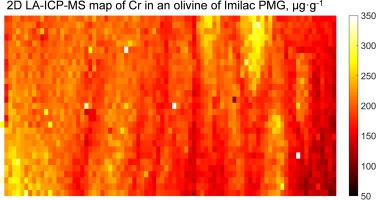Chemical Geology ( IF 3.6 ) Pub Date : 2020-12-20 , DOI: 10.1016/j.chemgeo.2020.119996 Stepan M. Chernonozhkin , Seann J. McKibbin , Steven Goderis , Stijn J.M. Van Malderen , Philippe Claeys , Frank Vanhaecke

|
Pallasites are stony‑iron meteorites consisting mainly of olivine and Fe-Ni metal with a formation history that remains widely debated. Despite their simple mineralogy, relatively limited data are available on their geochemistry and the lateral elemental distribution in individual pallasite olivine crystals. In this work, laser ablation - inductively coupled plasma - mass spectrometry (LA-ICP-MS) was used for the elemental analysis of both pallasite olivine and phosphate phases, including 2D trace element mapping of olivine crystals. While the results obtained are in good agreement with literature values, important differences are observed for Al and Ni concentrations compared with bulk analytical methods. The element distribution maps reveal complex zoning in pallasite olivine, which can be explained based on i) diffusion gradients formed during olivine cooling, ii) the crystal chemistry of element substitution due to charge-balancing, and iii) inherited features of olivine before the metal-olivine mixing. Oscillatory zoning in an olivine crystal from Imilac provides strong evidence for the olivine not being a restite of partial melting, but rather having crystallized from a melt. Concentrations of Cr and Al are correlated both within single olivine crystals and between olivine crystals of different pallasites, forming a 1:1 linear trend. This likely results from a spinel-type charge-balancing substitution mechanism in pallasite olivine. Additionally, principle component analysis of laterally resolved multi-element concentration data of pallasite olivine provides an independent measure of the genetic relationships between the different main group pallasites within their parent body (−ies). Rare earth element (REE) contents of pallasite phosphate grains range from concentrations typically measured for chondritic or primitive achondrite-like phosphates to more (light) REE-depleted signatures, revealing the overall primitive nature of the melts from which the phosphate minerals crystallized. Phosphate in pallasites may thus have formed through the consumption of apatites during pro-grade metamorphism, melting, and melt extraction. Combined, the trace element signatures of olivine and phosphate in pallasites of the main group (PMG) suggest that these meteorites are common products of planetary processes on chondritic or primitive achondrite-like precursor bodies, with the different subgroups highlighting distinct formation and evolution histories.
中文翻译:

原位微量元素分析和橄榄石和磷酸盐的二维制图对形成主族方石的新限制
辉石岩是主要由橄榄石和Fe-Ni金属组成的石铁陨石,其形成历史尚有争议。尽管其矿物学简单,但有关其地球化学和单个钯橄榄石晶体中的横向元素分布的数据相对有限。在这项工作中,使用激光烧蚀-电感耦合等离子体-质谱(LA-ICP-MS)来对棕橄榄石橄榄石和磷酸盐相进行元素分析,包括橄榄石晶体的二维痕量元素绘图。尽管获得的结果与文献值非常吻合,但与本体分析方法相比,Al和Ni的浓度存在重要差异。元素分布图揭示了在辉石橄榄石中复杂的分区,这可以基于以下条件来解释:i)橄榄石冷却过程中形成的扩散梯度; ii)由于电荷平衡导致元素置换的晶体化学; iii)在金属-橄榄石混合之前继承了橄榄石的特征。伊米拉克(Imilac)橄榄石晶体中的振荡区带提供了有力的证据,表明橄榄石不是部分熔融的辉石,而是从熔体中结晶出来的。铬和铝的浓度在单个橄榄石晶体内部以及不同方盘石的橄榄石晶体之间都是相关的,形成了1:1线性趋势。这可能是由于棕褐色橄榄石中尖晶石型电荷平衡取代机制所致。另外,侧面分解的橄榄石橄榄石多元素浓度数据的主成分分析为母体(-ies)中不同主群方石之间的遗传关系提供了独立的度量。磷灰石磷酸盐颗粒的稀土元素(REE)含量范围从通常测量的粒状或原始斜长石状磷酸盐的浓度到更多(轻量)REE贫乏的特征,揭示了磷酸盐矿物从中结晶的熔体的整体原始性质。因此,在前级变质,熔融和熔融提取过程中,磷灰石的消耗可能形成了磷灰石中的磷酸盐。结合起来











































 京公网安备 11010802027423号
京公网安备 11010802027423号